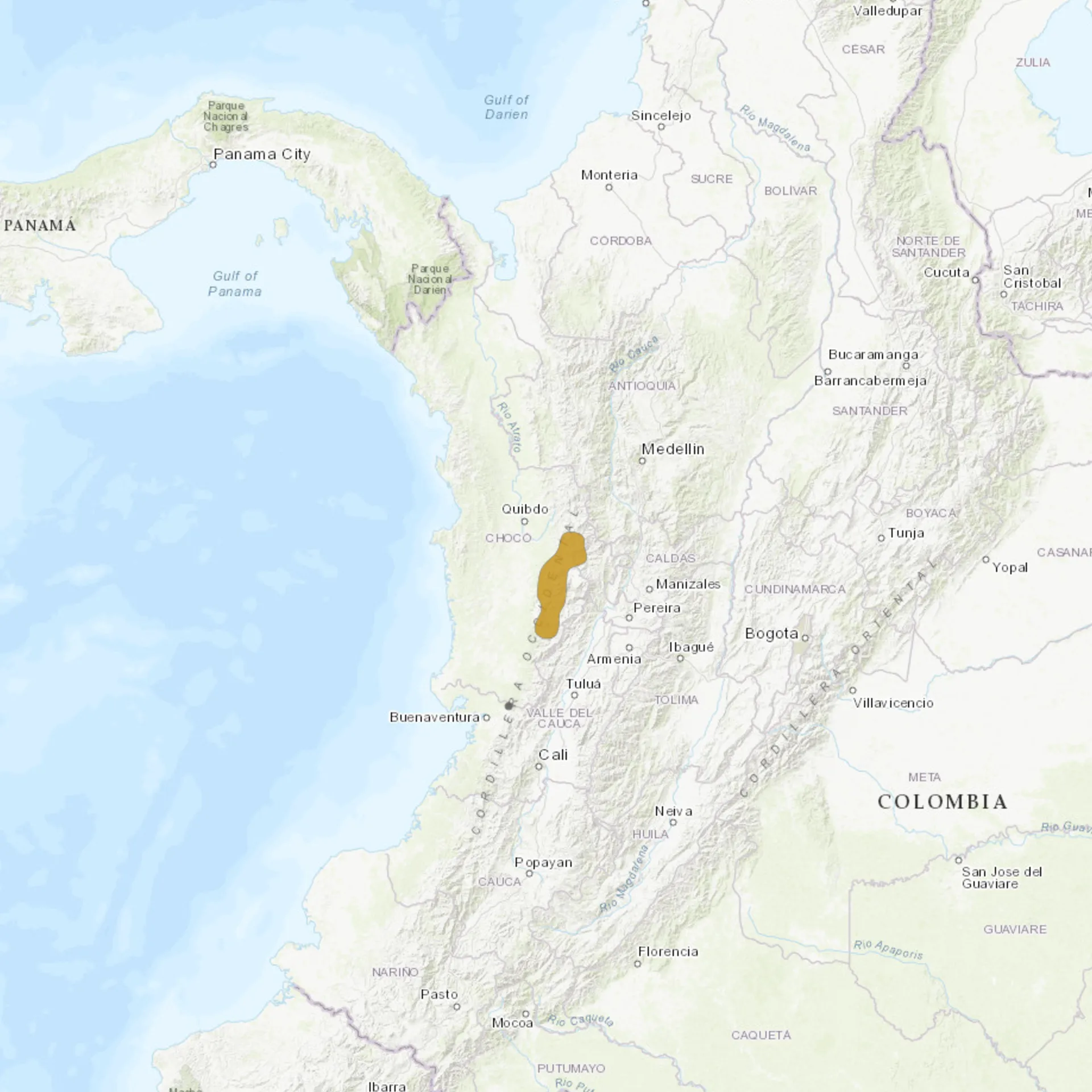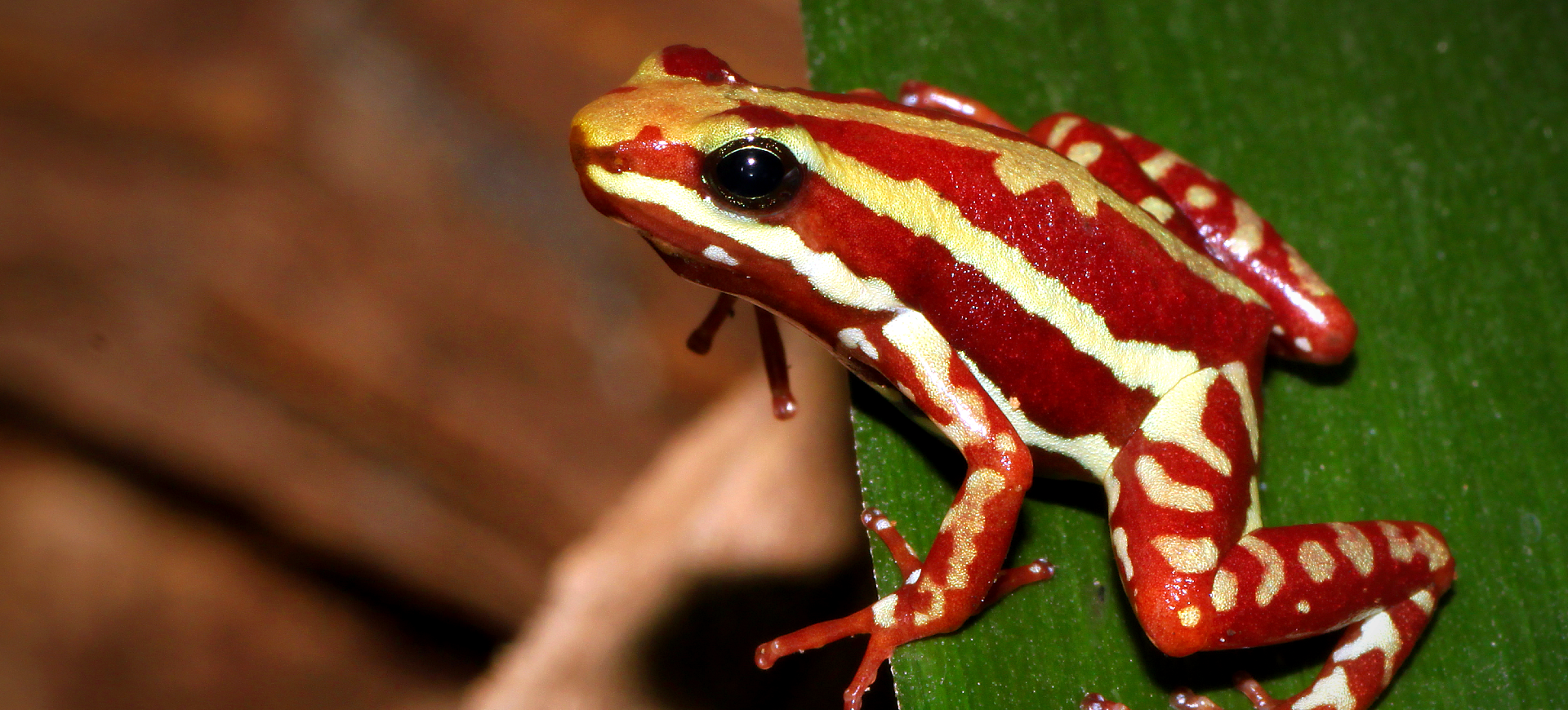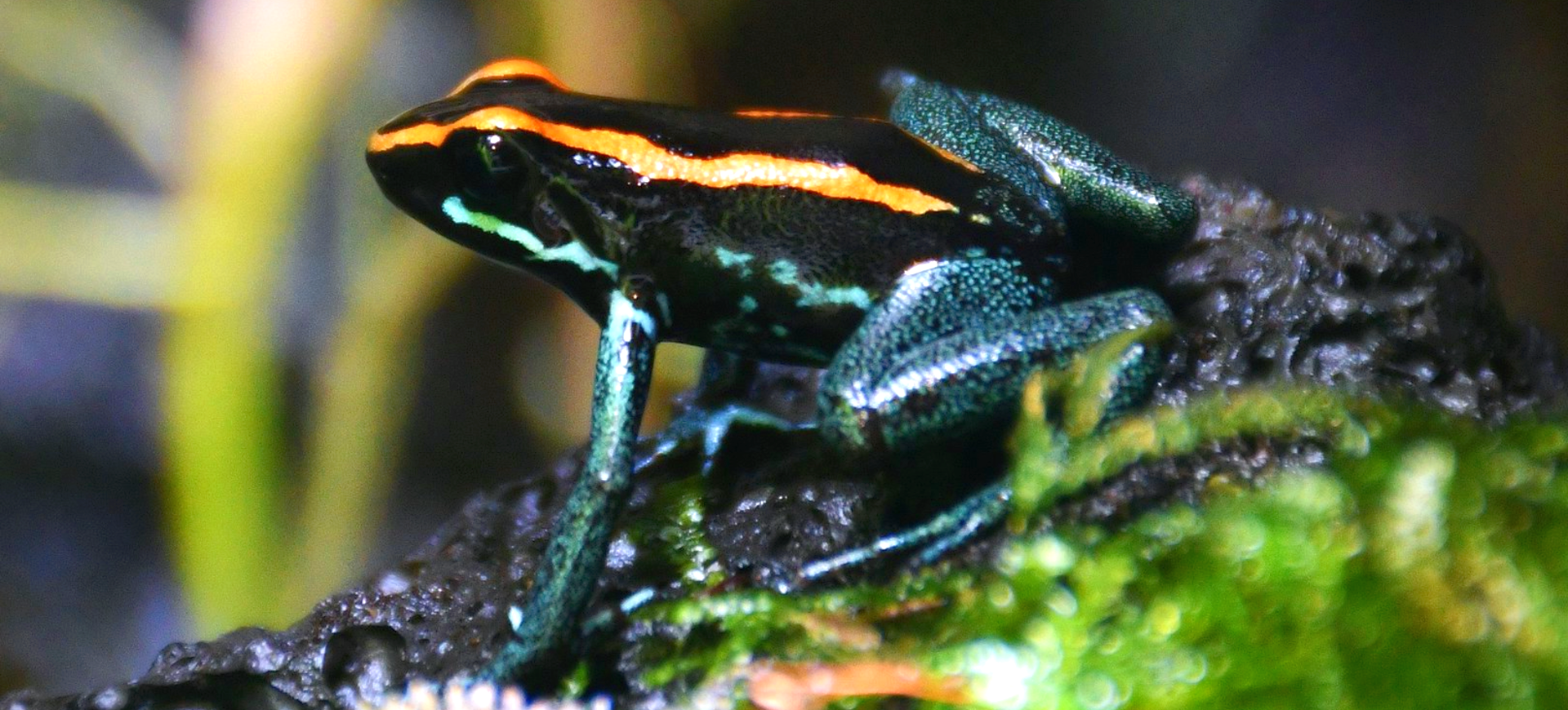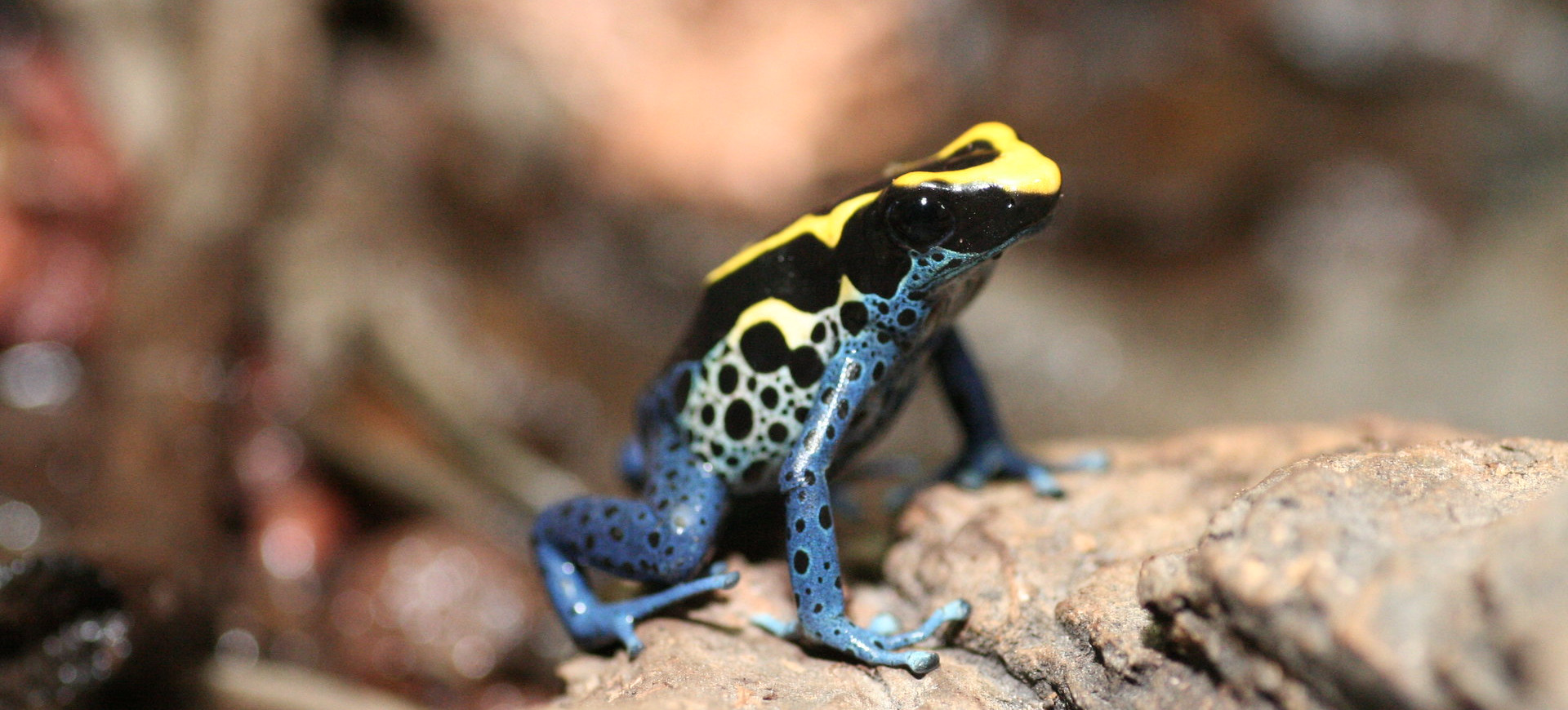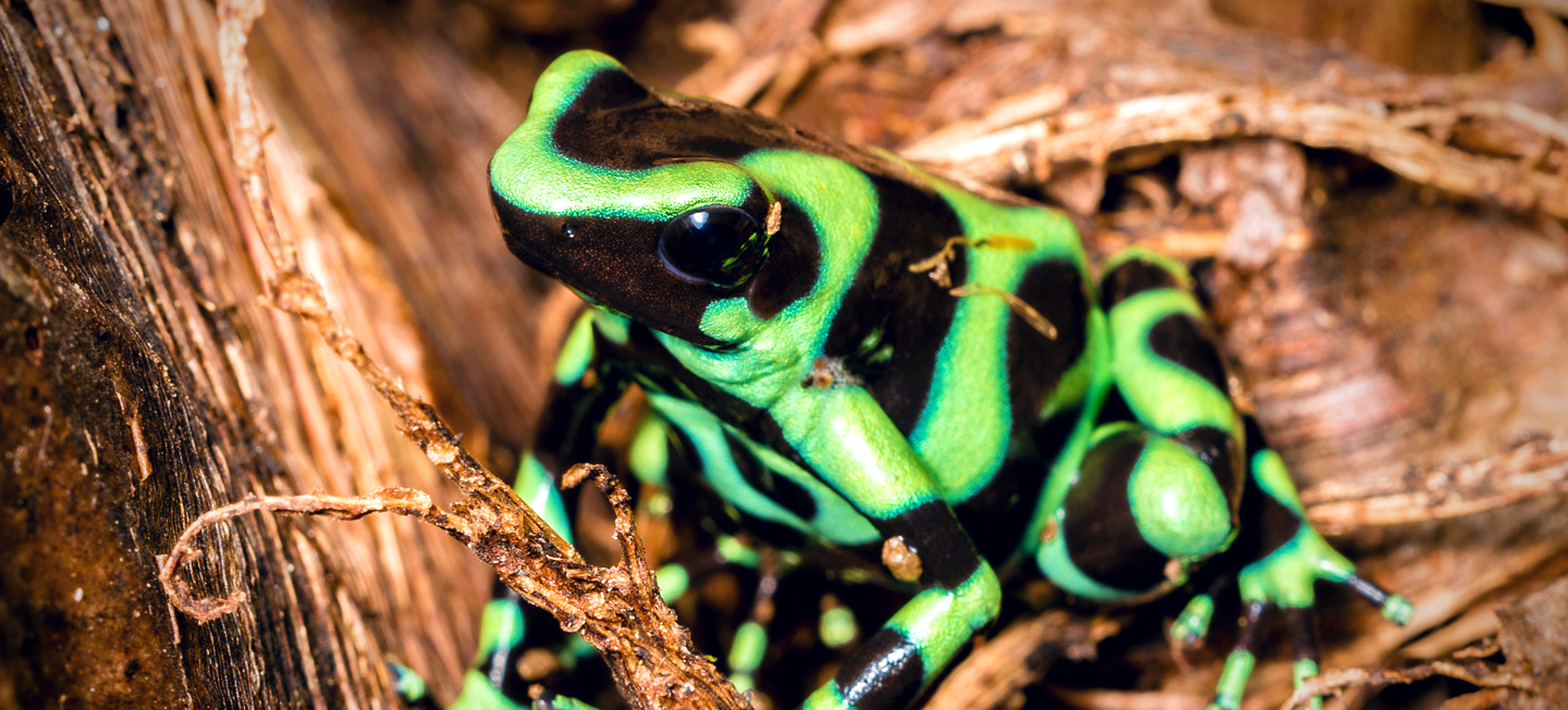Overview
The black-legged poison dart frog (Phyllobates bicolor) is a highly toxic amphibian native to the rainforests of Colombia. It is one of the most poisonous frogs in the world, capable of producing batrachotoxin, a potent neurotoxin that can be lethal to predators. This species plays a significant role in indigenous cultures, as its toxins were historically used to coat blowgun darts for hunting. Despite its dangerous defense mechanism, the black-legged poison dart frog is a relatively small and secretive species that relies on its bright coloration to deter predators.
These diurnal frogs spend most of their time on the forest floor or low vegetation, where they actively forage for small invertebrates. They have a unique parental care strategy in which males transport tadpoles on their backs to suitable water sources. Unlike many amphibians, black-legged poison dart frogs are highly territorial and engage in aggressive interactions to defend their breeding sites. Their toxicity is derived from their diet, as they accumulate toxins from consuming certain arthropods in their natural habitat.
Habitat destruction and illegal pet trade pose significant threats to this species, leading to population declines in some areas. Conservation programs focus on protecting their rainforest environments and regulating their trade to prevent further exploitation. Captive-bred individuals lack the toxins of their wild counterparts, as they do not consume the same toxic prey. Due to their ecological importance and striking appearance, black-legged poison dart frogs are a focal species in amphibian conservation efforts.
Taxonomy
Kingdom
Phylum
Class
Order
Family
Genus
Species
Type
Current distribution:
The black-legged poison dart frog is primarily found in the Chocó region of western Colombia, a biodiversity hotspot with high levels of endemic species. Its range is relatively restricted, and populations are concentrated in isolated forest patches due to habitat destruction. The species' distribution is closely tied to undisturbed rainforests, making it vulnerable to human activities such as logging and agriculture. Some populations may persist in protected areas, but overall numbers are declining due to environmental pressures.
Illegal collection for the pet trade has also impacted wild populations, despite regulations aimed at preventing overharvesting. Many individuals captured for trade do not survive transport, further exacerbating population declines. Efforts to establish captive breeding programs have reduced demand for wild-caught specimens, but habitat loss remains the primary concern. Climate change may also influence their distribution by altering rainfall patterns and humidity levels in their native range.
Physical Description:
The black-legged poison dart frog is a small, brightly colored amphibian with a distinctive bicolored pattern. Its body is typically yellow or orange, while its limbs, particularly the hind legs, are black or dark blue, creating a sharp contrast. This aposematic coloration serves as a warning to predators about its extreme toxicity, which can be deadly if ingested. Some individuals may exhibit slight color variations, but the characteristic two-tone pattern remains a key identifying feature.
This species has smooth skin and a compact, streamlined body adapted for navigating dense forest floors. Its toes have small adhesive pads that aid in climbing and gripping wet surfaces, though it is primarily a ground-dwelling species. Unlike many amphibians, it does not have webbed feet, as it is not highly aquatic and prefers moist terrestrial habitats. Males and females are similar in appearance, though females are often slightly larger and more robust than males.

Lifespan: Wild: ~10 Years || Captivity: ~20 Years

Weight: Male & Female: 0.1–0.2 oz (3–6 g)

Length: Male & Female: 1.2–1.6 in (30–40 mm)
Characteristic:
Native Habitat:
Black-legged poison dart frogs are endemic to the humid lowland rainforests of western Colombia, where they thrive in warm, wet environments. They prefer dense, shaded areas with abundant leaf litter and access to small streams or temporary water sources for breeding. Their habitat consists of primary and secondary forests, where moisture levels remain high throughout the year. These frogs are often found in areas with a thick canopy that protects them from direct sunlight and predators.
Unlike some amphibians, they do not rely on large bodies of water for breeding; instead, they utilize small pools, bromeliads, and leaf axils for tadpole development. Their terrestrial nature makes them more susceptible to habitat fragmentation, as they do not migrate long distances. Deforestation and agricultural expansion pose significant threats, reducing the availability of suitable microhabitats. Conservation efforts focus on preserving intact rainforest ecosystems to ensure the species’ long-term survival.
Climate Zones:
Biomes:
WWF Biomes:
Biogeographical Realms:
Continents:
Countries:
Diet:
Diet & Feeding Habits:
The black-legged poison dart frog is an insectivore, primarily consuming small arthropods such as ants, termites, beetles, and mites. Its toxicity is derived from alkaloid compounds found in its prey, which it metabolizes and stores in its skin. Captive frogs fed non-toxic diets do not develop their characteristic poison, making diet a crucial factor in their natural chemical defense. Their feeding strategy involves actively searching the forest floor for food, using their sticky tongues to capture fast-moving prey.
These frogs exhibit a high metabolic rate and must consume large quantities of food relative to their body size. They specialize in selecting alkaloid-rich invertebrates, which contribute to their chemical defenses. In captivity, they are often fed fruit flies, pinhead crickets, and springtails, which lack the necessary toxins to produce their potent skin secretions. Their diet is vital as they help regulate insect populations in their rainforest habitats.
Mating Behavior:
Mating Description:
Black-legged poison dart frogs have a monogamous mating system, with males actively courting females through vocalizations and physical displays. Males establish small territories and call to attract potential mates, with females selecting partners based on call quality and territory conditions. Once paired, the female lays eggs in a moist, hidden location, usually within leaf litter or under logs. Upon hatching, the male guards the eggs and carries the tadpoles on his back to water sources.
Reproduction typically occurs during the rainy season when humidity levels are highest, ensuring optimal egg and tadpole development conditions. The incubation period lasts about 10–14 days before the tadpoles emerge and require transport to small water bodies. Tadpoles undergo metamorphosis over weeks, developing into miniature versions of adult frogs. This species’ reproductive strategy relies on parental investment, increasing offspring survival in their challenging rainforest environment.
Reproduction Season:
Birth Type:
Pregnancy Duration:
Female Name:
Male Name:
Baby Name:
Social Structure Description:
Black-legged poison dart frogs are highly territorial and engage in aggressive behaviors to defend their space from intruders. Males establish and maintain small territories, often in areas with suitable breeding sites, such as leaf litter or near small water sources. Territorial disputes between males involve vocalizations, posturing, and occasional physical confrontations to assert dominance. Unlike many amphibians, they are diurnal, meaning they are most active during the day.. They use their bright coloration as a warning signal to deter predators.
These frogs exhibit monogamous pair bonding, with males and females working together to ensure the survival of their offspring. Males play a crucial role in parental care by guarding eggs and transporting tadpoles to water sources after hatching. Despite their territorial nature, they can coexist in small groups in the wild, provided that space and food resources are sufficient. Their social behaviors, including vocal communication and parental investment, contribute to their complex and unique reproductive strategy.
Groups:
Conservation Status:
Population Trend:
Wild populations of the black-legged poison dart frog are facing gradual declines due to habitat loss and collection for the pet trade. The species is still relatively widespread within its limited range, but fragmentation of rainforests has led to isolated subpopulations. While some protected areas offer refuge, deforestation threatens critical breeding and foraging habitats. Conservation programs emphasize habitat preservation and research to better understand population dynamics.
Captive populations have been successfully maintained in zoos and breeding facilities, reducing pressure on wild populations. However, illegal collection still occurs, particularly in regions with less stringent enforcement. Conservationists are working to ensure that sustainable trade practices are followed and that habitat destruction is minimized. Education programs and breeding initiatives aim to raise awareness about this species’ ecological importance.
Population Threats:
Habitat destruction is the most significant threat to black-legged poison dart frog populations, primarily due to deforestation for agriculture, logging, and urban expansion. The species relies on intact rainforest ecosystems with high humidity and abundant leaf litter, making it particularly vulnerable to habitat fragmentation. As forests are cleared, populations become isolated, reducing genetic diversity and increasing the risk of local extinctions. In some areas, pollution from agricultural runoff and mining operations further degrades their habitat, negatively impacting adults and aquatic larvae.
Illegal collection for the pet trade has also contributed to population declines, despite international regulations restricting the export of wild-caught individuals. Many frogs captured for the pet trade do not survive transport, leading to unnecessary mortality and further depletion of wild populations. Climate change poses an additional long-term threat, as shifting rainfall patterns and temperature fluctuations can alter their habitat and breeding conditions. Increased research and conservation efforts are essential to mitigate these threats and ensure the species’ long-term survival.
Conservation Efforts:
Several conservation initiatives aim to protect the black-legged poison dart frog, focusing on habitat preservation and legal protection. The species is listed under CITES Appendix II, regulating its international trade to prevent overexploitation. Protected areas in Colombia, such as national parks and reserves, help safeguard critical rainforest habitats where these frogs are found. Conservation organizations are working with local communities to promote sustainable land use and reduce deforestation pressures in key regions.
Captive breeding programs in zoos and research facilities help maintain stable populations and reduce demand for wild-caught individuals in the pet trade. Public education campaigns raise awareness about the ecological importance of these frogs and the threats they face in the wild. Scientific studies on their toxicity and ecological role contribute to better conservation strategies and habitat management plans. Monitoring wild populations is essential to assess trends and implement adaptive conservation measures.
Additional Resources:
Fun Facts
- The Black-legged Poison Dart Frog’s skin secretes batrachotoxin, one of the most potent natural toxins.
- Indigenous people have traditionally used the frog’s poison to tip their blow darts for hunting, hence the name “poison dart frog.”
- Despite their toxicity, these frogs are not harmful to humans unless the poison is ingested or enters the bloodstream.
- In the wild, the frogs acquire toxins from their diet, mainly from certain species of ants.
- These frogs are excellent parents, with males caring for the eggs and tadpoles.
- The bright coloration of these frogs is a classic example of aposematism, warning potential predators of their toxicity.
- The Black-legged Poison Dart Frog’s vibrant coloration is not just for show; it warns predators of its lethal toxicity.
- This frog’s poison, batrachotoxin, is so potent that indigenous people have used it to poison the tips of their blow darts for hunting.
- Interestingly, captive Black-legged Poison Dart Frogs are not poisonous. Wild frogs’ toxicity is derived from their natural diet, which includes certain species of ants.
- These frogs are among the few amphibian species that exhibit a high level of parental care, with the male frog often transporting and guarding the young.


